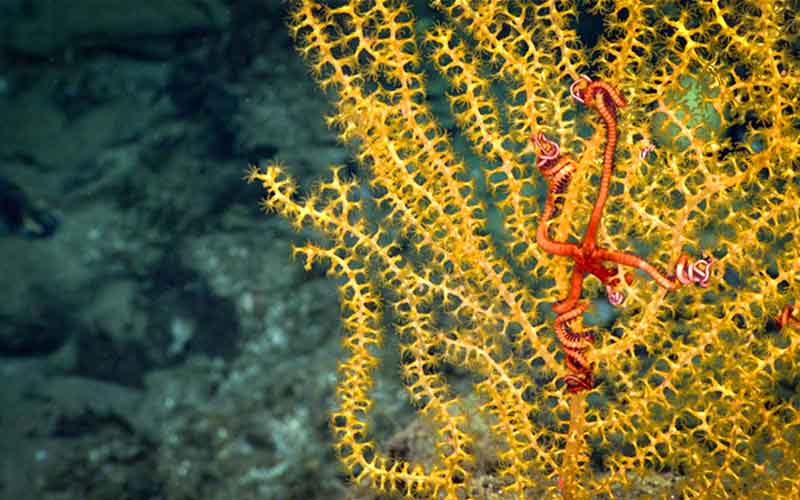
The Northeast Canyons and Seamounts Marine National Monument is the only area in New England that should count toward the 30x30 conservation goal – and only if its original protections are restored. Photo: OceanX/Bloomberg
Scientists worldwide say that protecting at least 30% of the planet by 2030 – an initiative known as 30×30 — is essential to save nature and build resilience against the impacts of climate change.
Here in New England, the Gulf of Maine is already warming faster than most other areas of the global ocean. That’s bad news not just for our marine wildlife and habitats but also for the coastal communities that depend on a healthy ocean for their livelihoods. So is the fact that New England has more overfished species than any other region in the country.
That’s why it’s so important that President Biden has committed to a bold national conservation vision. The administration recently previewed how it will achieve its conservation goals in a report to the National Climate Task Force.
We’re encouraged that the administration is taking swift action to protect the nation’s lands and waters because there’s no time to waste. But we cannot lose focus on the 30×30 initiative specifically, a goal President Biden committed to in his second week in office, and how it fits into the president’s broader vision. To that end, the administration’s recently released report leaves some critical details up in the air.
Here’s our take.
Biden’s Report Outlines a Bold New Vision
The Conserving and Restoring America the Beautiful report outlines a wide-ranging conservation vision for our country’s lands and waters – one that goes beyond an explicit 30×30 goal. In the report, the Biden administration acknowledges three threats currently facing the planet and people: climate change, the disappearance of nature, and inequitable access to the outdoors. And it calls on federal agencies to support locally led campaigns to “conserve, connect, and restore the lands, waters, and wildlife upon which we all depend.”
We’re glad to see such an emphasis on locally led campaigns. Local stakeholders must be engaged and active in these decisions. However, the report does not offer a clear process for how this will happen. We would like to see that clarified as this effort moves forward.
The report also recommends six priority areas for federal agencies:
- Create more parks and safe outdoor opportunities in nature-deprived communities;
- Support tribally led conservation and restoration priorities;
- Expand collaborative conservation of fish and wildlife habitats and corridors;
- Increase access for outdoor recreation;
- Incentivize and reward the voluntary conservation efforts of fishers, ranchers, farmers, and forest owners; and
- Create jobs by investing in restoration and resilience.
We agree that these areas of focus are crucial to advancing the conservation of our lands and waters in a way that is equitable and locally led. However, the report lacks concrete details about how the nation will advance these priorities and truly protect nature for generations to come.
Getting the Details Right Is Critical – Epecially on 30×30
Another of those missing details is how the administration will measure progress towards its broad conservation vision, as well as the 30×30 benchmark specifically. We cannot lose sight of scientists’ calls to protect 30% of the planet by 2030. It’s essential that we understand what level of protection the Biden administration will count towards that goal – because not all “protections” are created equal.
Heeding the scientific advice, CLF wants to see at least 30% of the ocean nationwide be highly to fully protected. That means no or very few extractive or destructive activities will be allowed. Those protections must also be permanent and well-distributed to protect the diverse habitats found throughout the nation’s waters. At the same time, we are pushing for 100% of our ocean and its resources to be managed sustainably.
Here’s an example of what we mean by highly to fully protected. In New England, the only area with a high level of permanent protection is the Northeast Canyons and Seamounts Marine National Monument – that is until President Trump reopened the area to commercial fishing in 2020.
We are urging President Biden to fully restore the Canyons and Seamounts monument so that commercial fishing will be prohibited once again. If that happens, then the monument should count towards the 30×30 goal.
On the other hand, our regional fishery managers have closed a handful of areas to destructive bottom trawling to protect important habitats. And, in some cases, like the Western Gulf of Maine Closed Area, these closures have been in place for over 20 years. Closing essential habitat to certain types of fishing is a key element of sustainable fisheries management.
However, these kinds of closures should not count towards 30×30 because they are limited in scope and do not address broader goals such as protecting biodiversity. Also, other forms of commercial fishing are still allowed in those areas. What’s more, the protections afforded them could be lifted at a later time.
Understanding how the Biden administration will consider these different kinds of protective measures is pivotal to moving forward both its conservation vision and the 30×30 initiative.
What Happens Next?
It’s exciting that the Biden administration has outlined such a wide-ranging conservation vision for the nation. However, the 30×30 initiative and details about how it will reach that benchmark must be included.
Robust protection of important ocean areas will deliver the maximum benefits for the long-term health of the ecosystem and a vibrant blue economy. To get there, the administration should ensure that it advances 30×30 through clearly defined, regional, science-based, and stakeholder-driven public processes to help us protect our most special ocean places.
CLF is committed to wide-ranging, local conservation efforts, including 30×30, to ensure a healthy ocean that benefits all New Englanders. We will count on your input and participation as we work with the Biden administration and all stakeholders to achieve this bold vision for our ocean.



